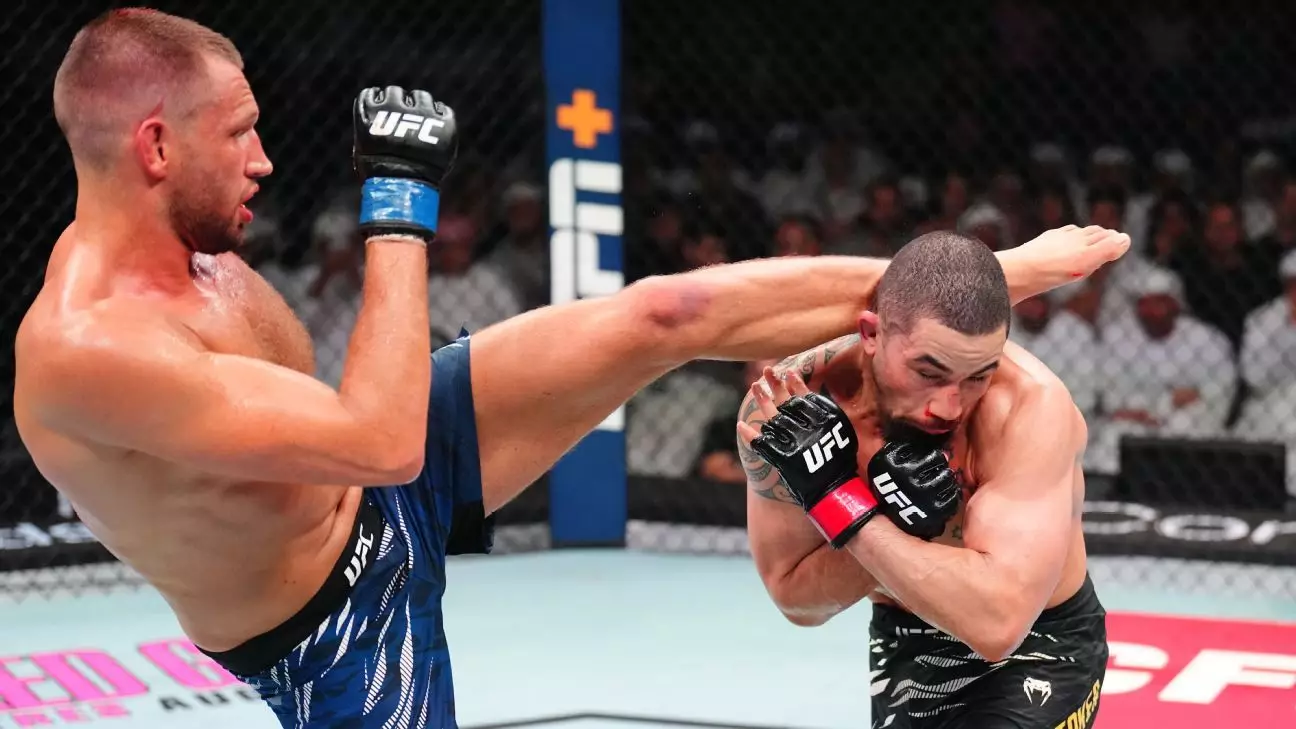In a sport where resilience and versatility are paramount, Reinier de Ridder has carved out a place of prominence through sheer determination and strategic mastery. His decisive victory over Robert Whittaker at UFC Fight Night in Abu Dhabi signifies more than just a tally on the win column; it highlights a fighter ascending the ranks with unrelenting momentum. De Ridder’s performance was a testament to his evolving skill set—a display of tactical pressure, grappling finesse, and striking volume that forced even a seasoned veteran like Whittaker to confront his limits.
De Ridder’s victory was not just about scoring points but making a statement. Outstriking Whittaker by a significant margin (169 to 100 strikes) and controlling the cage for more than nine minutes, he demonstrated comprehensive dominance. Despite the narrow split decision, the statistics underscore his aggressive approach and relentless work rate. It becomes evident that de Ridder’s style is rooted in a modern MMA philosophy where relentless pressure often outweighs the brilliance of isolated moments.
His confidence was palpable post-fight, openly expressing a desire for a title shot and even suggesting he was ready to face the division’s top contenders like Khamzat Chimaev or Dricus Du Plessis. This candidness reflects an athlete who understands his trajectory—not merely content with incremental victories, but eager to challenge the very best and redefine his limits.
The Art of Transition: From Grappler to Pugnacious Fight Finisher
De Ridder’s rise in the UFC showcases how a fighter’s skill set must be adaptable. Known primarily as a submission specialist, he’s proved his capacity to straddle both grappling dominance and striking volume. His prior wins, including a submission over Kevin Holland and a knockout of Bo Nickal, have cemented his reputation as a versatile threat.
In this bout, his strategy was clear: utilize takedowns to set up aggressive assaults, and maintain relentless pressure to wear down Whittaker. While Whittaker’s defensive skills kept de Ridder at bay on many takedown attempts, the relentless volume and unyielding forward pressure eventually compromised the Australian’s resilience. This highlights an evolving facet of MMA—dominance isn’t solely about grappling or striking, but the seamless integration of both to destabilize opponents.
Whittaker’s resilience, especially in the third round when he caught de Ridder and nearly finished him with strikes, underscores that even in victory, de Ridder was put through significant challenges. Yet, his ability to weather the storm and close out the fight on his terms speaks volumes. It reveals a fighter with a mindset geared toward dominance—an inevitability that he can impose his will when the stakes are highest.
Implications for the Middleweight Division
This victory signals a shift in the middleweight landscape. With Whittaker’s first consecutive losses since 2013 and de Ridder’s breakout year, the division finds itself at an inflection point. De Ridder, ranked 13th, has swiftly risen from underdog to a serious title contender, signaling that the division’s hierarchy is more open than ever.
His callout of top contenders like Khamzat Chimaev reveals not only his ambition but also a strategic awareness. Facing reigning or former champions will test his complete skill set—forcing him to elevate his striking defense and cage control further. Yet, his confident stance suggests he is prepared for the challenge, viewing his current momentum as a foundation upon which to build a championship run.
Moreover, de Ridder’s desire to end fights swiftly points to a mindset that could disrupt the traditional pacing of title defences—embracing an aggressive, relentless style that could make him a nightmare for opponents not suited to continuous pressure. His evolving approach ensures he’s not just a grappler or a striker but a hybrid threat capable of adapting mid-fight, an invaluable trait for champions.
The Road Forward: Potential and Peril
While de Ridder’s trajectory appears promising, the path to UFC gold is fraught with hurdles. Facing top-tier opponents will demand further refinement—especially against elite strikers and dynamic grapplers. His willingness to engage aggressively may also expose vulnerabilities, especially if opponents learn to capitalize on his forward pressure with counter-strikes or slick defenses.
Nevertheless, de Ridder’s journey exemplifies the modern MMA fighter’s blueprint: relentless pursuit of growth, strategic adaptability, and unwavering confidence. His recent performances have not only elevated his profile but have reshaped perceptions of what a middleweight contender can be. If he continues down this path, bolstered by his growing experience and desire for greatness, he could very well be the fighter to challenge the division’s reigning champions and claim a title for himself.
Reinier de Ridder embodies the fighter who refuses to accept limits, pushing beyond expectations with every fight. His raw aggression, coupled with tactical depth, makes him a fascinating competitor to watch as he transitions from promising prospect to bona fide title contender. The middleweight division might just have a new king in the making—if De Ridder’s relentless pursuit of victory remains unchanged.

